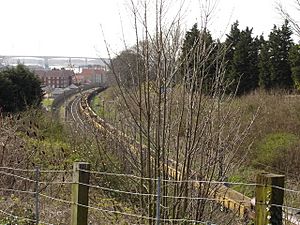Stoke Tunnel Cutting, Ipswich facts for kids
| Site of Special Scientific Interest | |
 |
|
| Area of Search | Suffolk |
|---|---|
| Interest | Geological |
| Area | 2.2 hectares |
| Notification | 1990 |
| Location map | Magic Map |
Stoke Tunnel Cutting, Ipswich, is a really important geological site in Ipswich, Suffolk, England. It's like a special outdoor museum that helps scientists learn about Earth's past. This area covers about 2.2 hectares, which is roughly the size of two large football fields! It's officially known as a Site of Special Scientific Interest (SSSI) because of its unique rocks and fossils.
What Makes Stoke Tunnel Cutting Special?
This place is super old! The rocks and fossils found here tell us about a time around 190,000 years ago. This was during a period called Marine Isotope Stage 7, which was a warmer time between two ice ages.
A Peek into the Past
Stoke Tunnel Cutting is part of an old river terrace from the River Orwell. Think of it as a raised, flat area that was once part of the riverbank a very long time ago.
Scientists have found amazing fossils here, showing us what animals lived in Suffolk nearly 200,000 years ago. Imagine seeing:
- Giant mammoths, which were like huge, hairy elephants.
- Woolly rhinoceroses, big rhinos covered in thick fur.
- Lions, similar to the ones we know today, but adapted to colder climates.
- Horses, much like modern wild horses.
- Small animals like voles.
- Even European pond tortoises, which are freshwater turtles.
These fossils help experts understand what the environment and climate were like so long ago. It's like piecing together a giant puzzle of Earth's history!
Why is this Place Protected?
Stoke Tunnel Cutting is a Geological Conservation Review site. This means it's recognized as one of the most important places in Great Britain for studying geology. Protecting sites like this helps scientists continue to learn about our planet's past and how it has changed over millions of years.
Currently, there is no public access to the site itself, as it's a sensitive area for scientific study.

